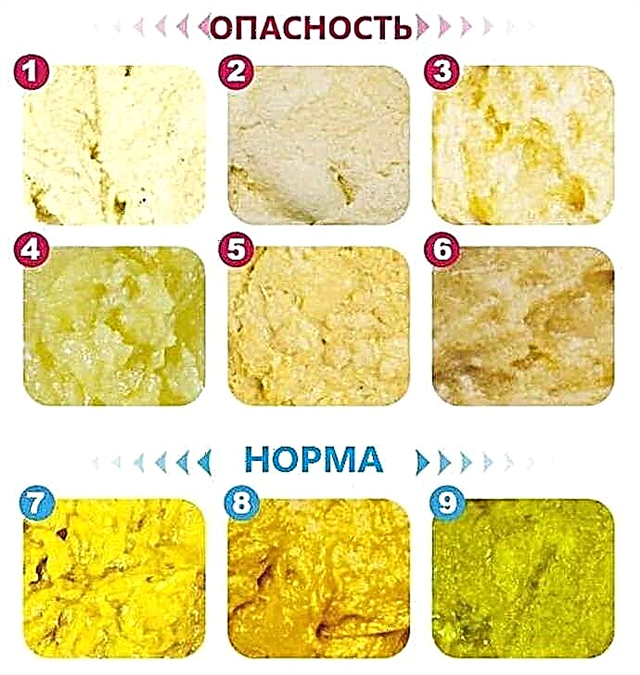It is believed that babies have perfectly smooth and pink skin. Sometimes she is able to acquire an unnaturally light shade. Marbled skin in a child can be a cause of concern for his health. The article will discuss why the skin tone in children is similar to marble, is it dangerous, and when you need to rush to the doctor.

Marbled skin in a child
What does "marbled skin" mean
The main sign of this skin color is the presence of a peculiar spotted or marble shade on it. This is due to the location of the smallest vessels close to the skin. Some of them can narrow, so the skin becomes bluish. Some vessels dilate, so where this happens, the epidermis turns red. As a result of uneven narrowing or expansion of the capillaries, a characteristic pattern is formed on the skin of the baby.
In normal cases, marbling appears all over the body. In others, the characteristic mesh becomes visible in one place, for example, on the cheeks or hands.
Important! Skin coloration, like marble, in newborns is not a painful condition. Its appearance is explained by the unstable functioning of the vegetative-vascular system.
A peculiar coloration of the epidermis in a newborn girl or boy is not always a pathology. It can be a natural condition of the skin.
Types of marbling
Conditionally, the marbling of the skin in infants is divided into 2 types: physiological and pathological. The physiological type is caused by the influence of external factors. A pathological change in the color of the epidermis appears due to any disease.
Why is marbling
The causes of marbled skin in babies are different. When diagnosing, doctors take into account all its manifestations.
Physiological features
The physiological factors that contribute to the appearance of a characteristic shade of the skin in infants include the following:
- thin and fair skin;
- a small layer of subcutaneous fatty tissue;
- prolonged crying;
- prematurity;
- hypothermia caused, in particular, by swimming in insufficiently heated water;
- vascular injury during childbirth;
- non-compliance with feeding rules;
- physique features.
Note! Usually, by the age of six months, there is no trace of the marble color of the child's body. By this time, blood circulation in the vessels is normalized, and the subcutaneous fatty tissue increases in volume.

Normal baby skin
Pathological factors
The pathological reasons for the marble shade of the epidermis include the following:
- Bacterial infections. In this case, the body temperature rises, the vessels spasm.
- Oxygen deficiency (hypoxia) during intrauterine development.
- Anemia.
- Jaundice.

Jaundice in a baby
- Congenital heart disease.
- An unfavorable genetic predisposition.
- Vein malformation.
- Brain cyst.
Rare causes
Rare causes of a marbled skin tone include Edwards or Down's disease. In these children, the skin takes on a light pattern from time to time.
Rarely, a crumb may have a syndrome of marbling of the skin. In this hereditary disease, the vessels are affected, and severe pathologies of the brain can develop.
Complication with temperature
Sometimes marbled skin can appear due to an increase in body temperature up to 37, sometimes 38-39 degrees. This is an alarming symptom, when it appears, you should consult a doctor. This must be done if you have a high fever, chills, vomiting, or seizures.
Sometimes, a child may be diagnosed with white fever. In this state, high temperature is combined with constriction of peripheral vessels. The limbs are cold from time to time.

White fever in a baby
Skin condition diagnostics
In order to find out the true reasons for the change in the color of the skin, it is necessary to be examined by narrow doctors. You will need to do an examination of the heart, large vessels with ultrasound. If the fontanelle is not yet tightened, you need to do an examination of the brain using ultrasound, later an MRI is prescribed. EEG and cardiogram give a lot of data about the health of the baby.
Will the marbling of the skin go away
As a rule, this symptom goes away on its own until a maximum of 6 months of age. Young parents need to be attentive and constantly monitor the baby. If you detect a deterioration in the baby's well-being, you need to contact a pediatrician.
What is recommended to do
If parents notice marble legs in a child or the appearance of a characteristic color all over the body, it is necessary:
- make a cardiogram;
- Ultrasound of the heart;
- diagnose the brain;
- pass the necessary tests.
Is it necessary to treat marbling of the skin
When it is established during the diagnosis that the marble shade of the epidermis appears for natural reasons, then there is no need to treat the baby. It is necessary to eliminate the influence of factors leading to the appearance of a specific symptom. For this it is recommended:
- avoid overheating or excessive cooling, as well as intense crying;
- ensure an acceptable temperature in the room where the baby stays;
- ventilate the room;
- do wet cleaning;
- wipe the baby after bathing with a soft towel;
- do a hand and foot massage.

Baby hand massage
Note! Early swimming will be very beneficial for your child. It can be started even if the baby is under a month old. Such small children can swim with a circle around their necks.
When to see a doctor
Parents need to see a doctor quickly when unnaturally colored skin does not go away as they get older or after warming. It is also necessary to consult a pediatrician if:
- a bluish tint of the nasolabial triangle is found;
- there is increased sweating;
- the skin is pale;
- body temperature rises or falls;
- the child is overexcited or lethargic;
- the baby lies with his head thrown back.
Note! Under no circumstances should you engage in self-treatment and use any pills, ointments and creams. This is harmful to the health of the baby.
What complications can there be?
Baby's marbled skin has no dangerous consequences. This is due to the fact that in most cases it goes away spontaneously up to 4 months.
Interesting facts, advice Komarovsky
Here are some facts about baby skin marbling:
- it can appear after a lot of crying;
- in 2% of cases, marble-like skin may be after a year, even up to 3 years;
- in the same number of babies, it is not possible to find the true cause of the change in skin tone;
- unnatural coloration occurs when overfeeding.
Komarovsky is convinced that marbled skin appears in all babies. This means there is no need to panic about it. In most cases, parents of babies under 4 months old do not need to see a doctor. If the marbling persists after the baby reaches four months of age, the child is referred to a pediatric specialist. Parents need to follow his advice.
Marbled skin in an infant is a normal variant or may be a sign of a serious illness. With a sharp deterioration in the baby's condition, consultation with a pediatrician is necessary. After the appropriate diagnosis, you can find out the true cause of the change in the shade of the skin of the baby.



